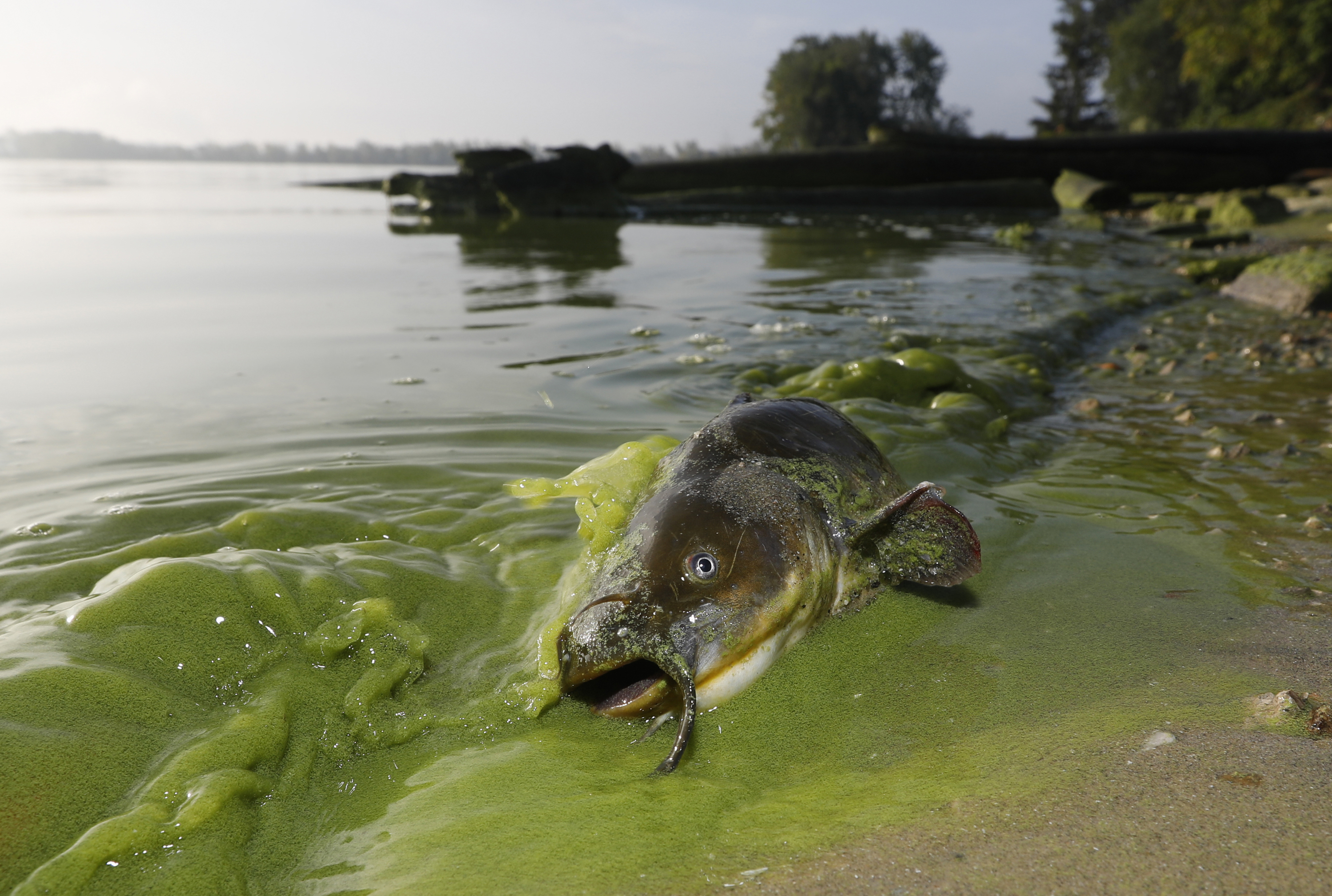
TRAVERSE CITY, Mich. (AP) — Lake Erie’s annual blob of pea-green algae is expected to be smaller this summer than a year ago following a relatively dry spring, but that doesn’t necessarily reflect significant improvement toward reducing the nutrient pollution that causes it, scientists said Thursday.
A forecast released by the National Oceanic and Atmospheric Administration predicts the algae bloom on the shallowest of the Great Lakes will reach 4.5 on its severity index — a “moderate” reading. That’s lower than last year’s 7.3 rating but higher than the 3.8 measured in 2018.
Anything above 5 indicates a severe problem. The measurements indicate the bloom’s biomass — the amount of algae in the water for an extended period.
The largest occurred in 2011, which had a severity index of 10, and in 2015, when it hit 10.5.
The drop-off this year is expected because of a decrease in spring rainfall from 2019, NOAA oceanographer Rick Stumpf said. Spring storms can wash newly applied manure and chemical fertilizers that feed the algae into the lake and its tributary streams and rivers — particularly the Maumee River on the lake’s western side.
“A smaller bloom forecast for Lake Erie and the surrounding coastal communities is encouraging, but we cannot be complacent,” said Nicole LeBoeuf, acting director of NOAA’s National Ocean Service.
Lake Erie’s blooms consist of blue-green algae or cyanobacteria, which can produce a liver toxin called microcystin that is harmful to humans and animals. The level of toxicity at a given time isn’t connected to the size of the bloom, because toxins in a larger mass may be less concentrated than in a smaller one.
NOAA and other U.S. and Canadian agencies have set a goal of reducing the Lake Erie bloom to a 3 on the index, which was last seen in 2012.
Ohio, Michigan and the Canadian province of Ontario also have pledged to reduce runoff of phosphorus — a nutrient that feeds the blooms — by 40% by 2025 from the 2015 amount.
But measurements in the Maumee River and other key tributaries have shown no trend toward lower phosphorus inputs to the lake since the early 2000s, said Laura Johnson, director of the National Center for Water Quality Research at Heidelberg University in Ohio.
About 325 tons of the type of phosphorus that nourishes algae is expected to flow into the lake’s central and western basins this year, Stumpf said. That total would need to be 30% lower to meet the reduction goal.
“We cannot cross our fingers and hope that drier weather will keep us safe,” said Don Scavia, a professor emeritus at the University of Michigan and a member of the forecast team.
“These blooms are driven by diffuse phosphorus sources from the agriculturally dominated Maumee River watershed,” Scavia said. “Until the phosphorus inputs are reduced significantly and consistently so that only the mildest blooms occur, the people, the ecosystem and the economy of this region are being threatened.”
In addition to endangering health, algae blooms can boost water treatment costs and harm tourism as fewer people visit the lake for fishing and swimming.
Cyanobacteria, or blue-green algae, began growing in the lake last week, NOAA said. A visible bloom is expect to begin showing up in mid to late July.
“Much of the lake will be fine most of the time,” Stumpf said, but areas with high concentrations of algae will have a “strong risk of scum” in the water when winds are calm.
Ohio and Michigan have encouraged farmers to make greater use of best-management practices such as planting off-season cover crops and buffer strips between croplands and streams to prevent runoff. Applying fertilizer in ways that prevent it from being washed away can reduce levels of the type of phosphorus that feeds harmful algae, Johnson said.
Environmentalists have long urged the states to make such measures mandatory. Ohio announced plans this year to impose specific limits on phosphorus flows.
“Lists of best management practices are nice but leaders need to provide an accounting of progress and a plan of action so the public knows where things stand and how their money is being spent,” said Crystal M.C. Davis, policy director with the Alliance for the Great Lakes.
Read more on toxic algae on Great Lakes Now:
Lake Erie Algae: 2019 was bad but could have been worse
7.5 on Severity Index: Projections for Lake Erie toxic algae worse than 2018
Animal Culprit: Study Points to Animal Farms as Growing Contributors to Lake Erie Algae
Great Lakes Moment: Harmful algal blooms negatively impact the Lake Erie economy
Understanding Algal Blooms: Conference reveals new projects, looks at Chesapeake Bay’s example
API key not valid. Please pass a valid API key.Featured image: In this Sept. 20, 2017, file photo, a catfish appears on the shoreline in the algae-filled waters of North Toledo, Ohio. (Andy Morrison/The Blade via AP, File)




